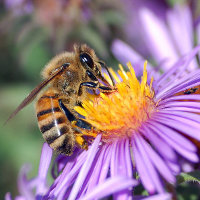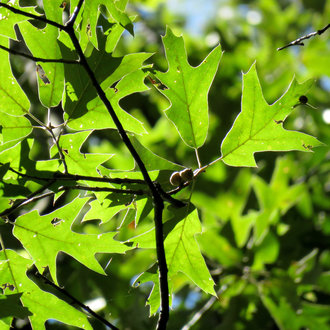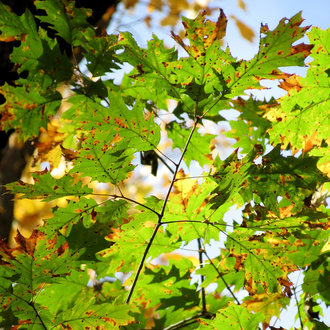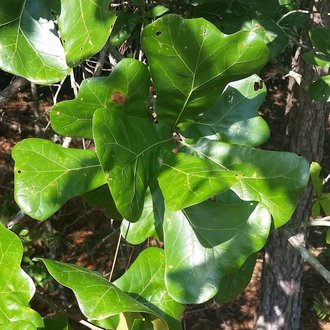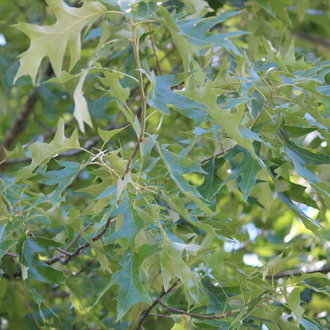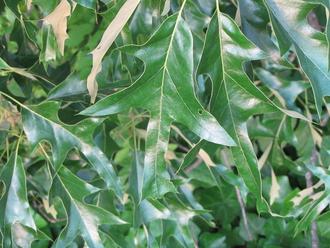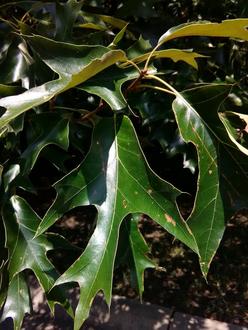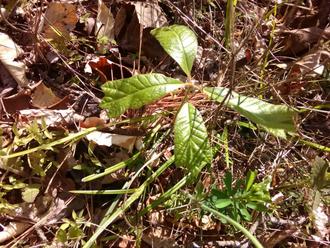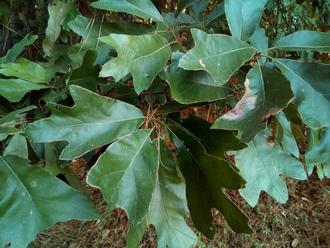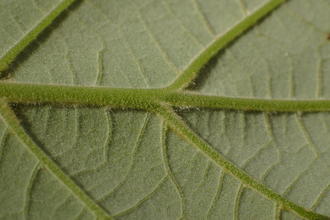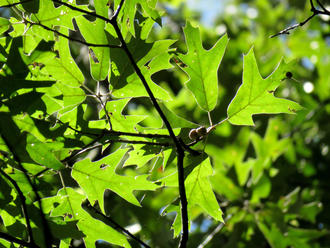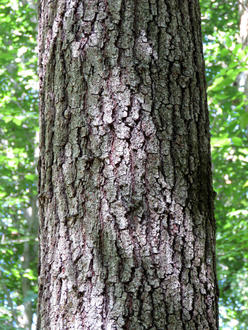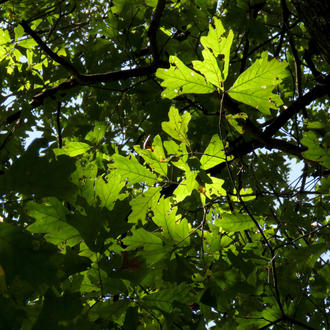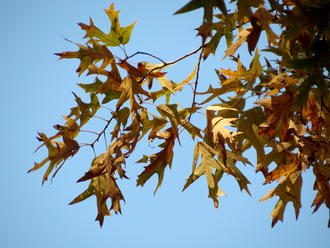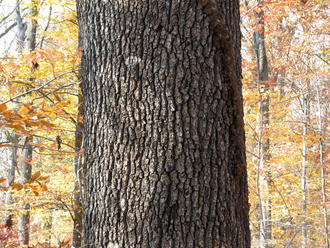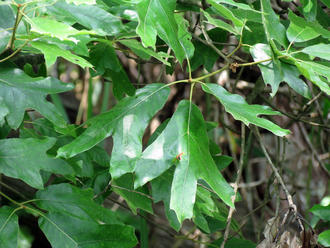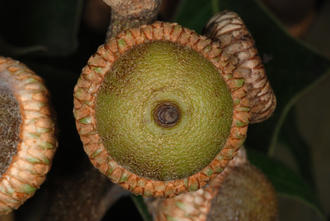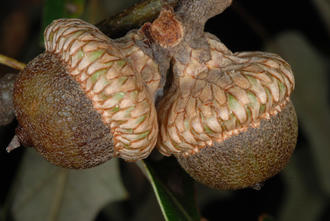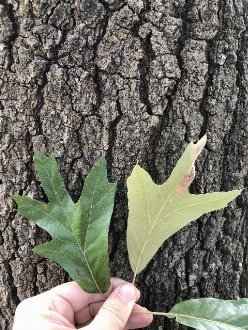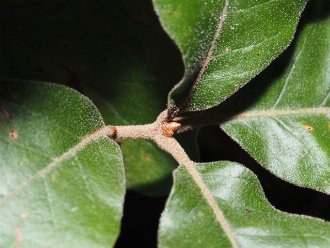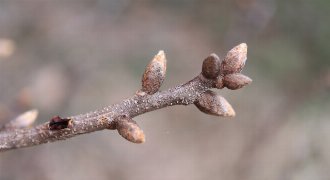Southern Red Oak (Quercus falcata Michx.)
Also known as Spanish oak.
Some sources, particularly older ones, lump cherrybark oak (Quercus pagoda) in with this, calling it Quercus falcata var pagodifolia. We treat them as separate species, per POWO and most contemporary authorities.
↑Summary
A medium to large red oak with, as the name suggests, a more southerly distribution than the northern red oak (Quercus rubra), although their ranges overlap considerably.
↑Similar Plants
↑Habitat
Southern red oak is primarily found in and near the southeastern US, most often in sloped terrain in communities transitional between pine-dominated uplands and mid-slope hardwood forests, where it is an important component of forests, but usually occurs mixed with other species. In Florida, it also occurs in longleaf pine savannas. It is also a dominant tree in the Texas pineywoods and in post oak savannas of the region. Especially in the parts of its range where cherrybark oak (Quercus pagoda) does not occur, southern red oak is also occasionally found on moist bottomlands, where it is a more minor component of forests. Where these species overlap, cherrybark oak is more competitive in bottomlands.
It prefers upland sites, especially those with dry soils, but is also sometimes found on well-drained sites in bottomlands and near water. It tolerates a wide range of soil textures including sand, loam, and clay, and a wide range of soil pH, but is usually limited to soils of low fertility. It is also limited to low elevations, occuring only up to about 2,000 ft (610m). In the north of its range it is uncommon and restricted to spceific habitats with harsh soils, including rock outcroppings, serpentine barrens, or areas with acidic clay soil. In the south of its range, in Florida, it is also uncommon, often growing where sandy soil covers a substrate of limestone. It prefers sloped terrain and is often found on steep slopes, and is less common in flatter terrain, where it often grows on micro-sites elevated slightly above its surroundings.
The fire tolerance of this species is intermediate. Its bark is relatively thin, leading trees to be easily damaged or top-killed in severe fires, but it survives low-intensity ground fires more easily, and it can survive more severe fires by resprouting. Very old trees can have slightly insulated bark, offering some protection from more severe fires, but are less likely to resprout. Overall, southern red oak is more fire-tolerant than water oak (Quercus nigra), and about as tolerant as post oak (Quercus stellata). It readily colonizes sites where fire has opened the canopy, but does not always survive long-term on these sites if they burn more severely. It moves into pine forests in the absence of fire and can be an important species leading to the conversion of pine savanna to mixed or hardwood-dominated forests. As such it has benefitted from fire suppression.
Southern red oak usually occurs together with numerous other oak species, including white oak (Quercus alba), black oak (Quercus velutina), scarlet oak (Quercus coccinea), post oak (Quercus stellata), and blackjack oak (Quercus marilandica). Other hardwood associates include American sweetgum (Liquidambar styraciflua), black tupelo (Nyssa sylvatica), and various hickories (Carya sp.) In the Appalachians, it is also associated with chestnut oak (Quercus montana), pitch pine (Pinus rigida), and Virginia pine (Pinus virginiana). In the southeastern coastal plain, it associates with loblolly pine (Pinus taeda) and shortleaf pine (Pinus echinata). When it occurs on bottomlands, it is most likely to share habitat with swamp chestnut oak (Quercus michauxii), willow oak (Quercus phellos), and in the north of its range, pin oak (Quercus palustris), as well as with other hardwoods including red maple (Acer rubrum).
Compared to other oaks, southern red oak is less shade-tolerant than white, black, or chestnut oak, and is more likely to occur on sites where adverse soil conditions lead to a more open forest canopy. It overlaps less in habitat with northern red oak (Quercus rubra), which is much more shade-tolerant and less drought-tolerant.
↑Life Cycle
Seeds germinate underground after a period of cool, moist conditions. Most seeds are viable and will germinate in suitable conditions. Seedlings grow well in full sun; shade tolerance is low to medium.
Trees usually start producing seed around 25 years of age, with seed production peaking around 50-70 years. Lifespan is about 150 years.
Trees are able to resprout from the roots after being top-killed, but do not otherwise reproduce vegetatively. Resprouting is more common in younger trees.
Acorns are distributed both by squirrels and by blue jays, both of which store acorns for the winter. Gravity also helps distribute the seeds of trees growing on steep uphill sites.
↑Faunal Associations
Supports a wide array of insect herbivores, typical of the community of insects that feed on oaks.
The acorns, being smaller than many other oaks, are an important source of food for large birds, which help distribute their seeds.
↑Uses
Southern red oak is one of the most important timber species of oak, where it is valued for its central, straight trunk. It is usually considered slightly inferior to northern red oak, but its wood is often lumped together with other oaks of the red oak group when sold. This species however does not respond well to clearcutting, as it will often not regenerate well on a fully open site. In order to sustainably harvest this species, a shelterwood system can be used, removing specific trees from the canopy but leaving enough trees in the canopy to ensure that it regenerates in the understory. There is a narrow time-window for using such system, however, because if the remaining canopy is removed too late, the young southern red oaks can develop bad form due to heavy sprouting from the bark in response to higher light levels.
Southern red oak is occasionally used as a landscaping plant, and is probably underutilized as such. The northern limit of this species is due not to cold tolerance but other ecological factors, so this plant can be planted farther north than its native range. It tolerates a wide range of soil conditions and can grow in adverse conditions where other trees struggle, and it is faster-growing than most oaks and tends to have attractive foliage and an attractive form. In landscaping, it will grow on just about all but the most poorly-drained sites or heavily-shaded sites.
↑Related Plants
This species is closely related to the cherrybark oak (Quercus pagoda), which was once classified as a variety of this one. That species has a more limited distribution, but with significant overlap in the Mississippi Alluvial plain as well as some parts of the Carolinas.
Numerous other oaks of the red oak group (Quercus section Lobatae) overlap with this species in range.
↑Notes
We discourage the use of the misleading common name "Spanish Oak" because this species is neither native to, nor found in the wild in Spain. The name "Southern Red Oak" is more descriptive in that this species is mostly limited to the southeastern US and is one of the more common and widespread red oaks in this region.
↑Links & External Resources
• Southern Red Oak | The Wood Database (About This Site)
• Quercus falcata (Spanish Oak) | Illinois Wildflowers (About This Site)
• Quercus falcata (Southern Red Oak) | USDA PLANTS Database (About This Site)
• Quercus falcata (Southern Red Oak) | Missouri Botanical Garden Plant Finder (About This Site)
• Southern Red Oak | Virginia Tech Dendrology Factsheets (About This Site)
• Quercus falcata | Biota of North America Project (BONAP) (About This Site)
• Quercus falcata | NatureServe Explorer (About This Site)
• Quercus falcata | Flora of North America (About This Site)
• southern red oak (typical) | Silvics of North America (About This Site)
• Southern Red Oak | Maryland Biodiversity Project (About This Site)
• Quercus falcata Michx. | Plants of the World Online (POWO) (About This Site)
• Quercus falcata Michaux (Southern Red Oak, Spanish Oak) | Digital Atlas of the Virginia Flora (About This Site)

